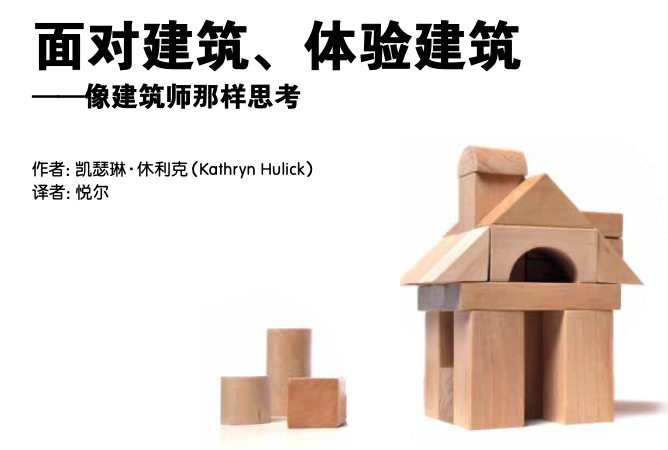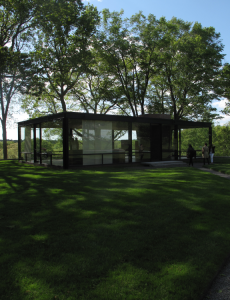This article appears in the March 2022 issue of Front Vision, an educational Chinese-language magazine for kids. It is reproduced here with permission.

As a small child, did you turn chairs and blankets into hiding places? Or did you use building blocks to create towers? If you did, you had to think like an architect. An architect is someone who transforms space with buildings, gardens, and other structures. But they don’t do this merely for practical purposes. Architects are artists. Instead of paint or clay, they work with structures and spaces to express important ideas or evoke human emotion. Architects are also scientists and engineers, who study the world and find ways to solve problems and create order. Architects might even question existing ways of thinking to move civilization forward.
Anyone can learn to understand and appreciate designed spaces the way an architect does. The first step toward this goal, according to Hal Box, is to love architecture. Box is an architect at the University of Texas at Austin and the author of the book, Think Like an Architect. In the book, he writes about why people might love architecture: “It’s a way of creating something from nothing, of bringing order to things in a satisfying way. It’s a way of helping people improve the way they live. It’s an art that rewards you and the community.”
A love for architecture will inspire a person to seek out structures that spark emotion or challenge the intellect. This is what separates architecture from plain old buildings. “To be architecture, it must engage people in some powerful way,” says Mina Chow. She is a licensed architect and professor at the University of Southern California in Los Angeles and creator of the film Face of a Nation: What Happened to the World’s Fair?
Even without formal training, a person can learn a lot about architecture simply by experiencing it. If possible, you should travel to visit important examples of architecture. When you are going to see a famous building or famous site, what should you think about or look at? Hal Box suggests ten different ways “to explore and understand a building,” and this list of seven steps is inspired by his ideas. Following these steps will help you better appreciate well-designed spaces of all kinds. Some of these steps may require some research or the assistance of a guide or other expert who can answer questions about the architecture.
Look
When you first arrive at a site, look around. Also, look up! Many interesting aspects of architecture will be above eye-level. You should try to look past the fact that the things you see are windows, doors, columns, floors, or ceilings. Instead, you should look at the underlying visual elements that make up these things and how they all relate to each other as a complete composition. The word “composition” refers to the organization of elements.
Instead of seeing “a window,” see everything that makes that particular window unique and interesting in the context of the entire building. Hal Box suggests, “See how the light hits the surfaces. Notice the shape of the shadows… Focus, in turn, on color, form, texture, proportion, rhythm, silhouette, mass.” Try to notice anything captivating, beautiful, or unusual about each of these elements.
“Color” seems obvious, but keep in mind that colors change in different types of lighting and when other colors surround them. “Form” refers to shapes, such as circles or triangles, cylinders or cubes. “Texture” refers to surfaces, which may be smooth or rough or patterned. Proportion refers to the sizes of things, especially in comparison to each other. For example, how large are the windows in comparison to the wall? To the doors? To a person? “Rhythm” refers to repetition of visual elements. For example, the Colosseum in Rome contains repeating arches, columns, and windows. “Silhouette” refers to a flattened, two-dimensional version of a three-dimensional shape. The silhouettes of a building change as you move through it. Finally, “mass” refers to physical size and weight.
Feel
Architecture is about the experience of being in a space. You can see many of the interesting visual elements of architecture in photos or videos. But you can’t truly experience architecture until you go inside and move around. Listen to how sounds echo, sniff the air for interesting smells, and feel any textures that you are allowed to touch. Also notice your emotional state. How does moving through this building or designed space make you feel? Is it vast and overwhelming, or simple and sparse? Does it inspire awe, wonder, angst, curiosity, or some other emotion?
The 9/11 Memorial & Museum site in New York City, by Peter Walker, is an example of architecture that inspires emotion. Thousands of people died on September 11, 2001 when hijackers flew passenger planes into the twin towers of the World Trade Center. The site honors the devastating grief and loss of this tragedy in its architecture. No new buildings were erected on the site. Instead, the memorial is located underground, in square holes that mark out the places where the twin towers of the World Trade Center once stood. “Absence can mark loss,” says Chow. “It is equally as powerful as presence. When you lose somebody or something important, that absence is very powerful.” The 9/11 Memorial captures absence in a profound and moving way.
The 9/11 Memorial also used landscaping to alter sound at the site, Chow points out. While the surrounding city is extremely noisy, the memorial is not. Waterfalls and trees mute the city sounds, creating a quiet, naturalistic setting that honors those lost. Even someone who doesn’t yet know the history of 9/11 could feel a sense of loss or grief just from moving through this site.
Think about Function
Learn about why this building or site was made. What was its function? And how has that function changed? If it is a gothic cathedral, it was originally build for religious worship and may still be used this way. If it is a medieval castle, it may have once been home to royalty but now functions as a museum or historical site.
The Eiffel Tower in Paris, France, by Alexendre-Gustave Eiffel, was originally used as the entrance to the 1889 World’s Fair. Now it’s a famous symbol of the country that people adore. But at the time it was built, it wasn’t so popular. Critics of the day, “completely trashed it,” says Chow. “They said the most insulting things.” A group of prominent artists wrote a letter calling it ugly, monstrous, and dishonorable. They likely hated it because it challenged people’s understanding of what a building was supposed to be and do. Over time, as culture changed, what was once bizarre became iconic.
Notice Structure and construction
Try to understand the engineering of the building or site. Any structure must overcome gravity in order to stand. It must also withstand weather events and changes in temperature. Architects must understand engineering or work closely with engineers in order to make their works strong and long-lasting. When you think about structure, you should think about how all the parts of a building are held in place. Look for ways in which the architect has made surprising or unusual choices that may seem to defy gravity.
For example, the house Fallingwater by Frank Lloyd Wright in Mill Run, Pennsylvania features a series of terraces that hang out over a waterfall, seemingly floating there. What holds them up? Wright worked with engineers to create cantilevers, which are rigid horizontal structures that only need support at one end. Wright and the engineers used concrete reinforced with steel to create an exceptionally strong material that could extend quite far out from the main structure while still remaining strong.
Remember that architecture doesn’t just appear. It must be built, stone by stone or piece by piece. Common types of construction include wood-framed, steel-framed, concrete-framed, and masonry (brick or stone). To understand this aspect of architecture even more thoroughly, visit a construction site and watch the work in progress.
Notice Materials
An architect may choose from many different materials, ranging from stone, wood, and bricks to steel, concrete, glass, and plastics. Think about whether the materials are pressing down, like bricks or stone, or pulling apart, like the cables that hold up a bridge. The materials may be heavy or light, rough or smooth, solid or see-through, natural or human-made. Think about why the architect might have chosen their materials.
The Eiffel Tower was the first very tall building made of metal. Its construction earned Alexendre-Gustave Eiffel the nickname, “magician of iron.” He proved that it was possible to build tall using metal, explains Chow. The steel construction techniques used to erect skyscrapers today were originally inspired by this iconic building.
The Glass House by Philip Johnson is a house in New Canaan, Connecticut with see-through, glass walls. This choice of materials is surprising because the clear walls confuse the distinction between inside and outside. From any point inside, you can see all of the surrounding natural environment. And anyone outside can also see the people inside.
Think about the Context
A building never exists on its own — it is built in a particular place and time. You can only fully understand it if you understand the culture that built it, the history that came before it, and the natural world that surrounds it. “Architecture ALWAYS considers context,” says Chow, Context includes “the physical, environmental, cultural, historical, and other factors that could affect its design.”
The Jean-Marie Tjibaou Cultural Center by Renzo Piano in Nouméa on the island New Caledonia incorporates all of these factors beautifully. The center was built to honor and bring recognition to the indigenous Kanak people, who had endured many centuries of oppression, exploitation, and enslavement. The forms of the buildings and pavilions were inspired by a traditional Kanak village. Piano combined traditional building materials and techniques with modern ones to create this masterpiece.
Think outside the box
What makes this example of architecture unique or special? What might you not have noticed in any of the other steps?
You could follow these steps to understand and appreciate an existing building or designed site. Or, you could follow them to think of an idea for a new one! Imagination is a very important part of architecture. Hal Box calls it “dreaming.” Dreaming is playful and fun. It is a child building a sandcastle or a young couple imagining their dream house. Box writes, “Between the dream and the building there are needs for skill and knowledge, but first and always you must focus on the dream.” If you could build anything, what would it be? What can you imagine?
Epilogue
This article is like the starting point of a journey. Reading about architecture or taking courses in architectural history or structural engineering will help expand your knowledge. Training in painting, sculpture, music, construction, landscaping, and other related fields can also help you better understand architecture. So can reading an architect’s description of their own work. Training and research can only get you so far, though. You can’t truly appreciate architecture until you visit it and experience it for yourself.
Ten years ago, I got to tour The Glass House (Philip Johnson, New Canaan, Connecticut). I am no architect, and I had no training in architecture or engineering. However, I studied studio art in college. I learned about composition, drawing, color theory, and many other aspects of the visual arts. This experience helped me look at the structure around me as a composition, and not just as a building. As I approached, I noticed the simple, flat shapes and straight lines. I noticed that the building was low and wide, comforting proportions that feel safe. Johnson said that he had been inspired by the simple cube.
As I stepped inside, I looked around. I felt like I was still outside. The fact that I could see the entire surrounding landscape was inspiring, but also unsettling. I could be seen from any direction, too. The only place in the house that isn’t visible from the outside is the bathroom (it’s located in a circular pillar near the center of the house). It was a sunny day when I visited, but I wondered what it might be like to experience a thunderstorm or blizzard from inside this home. The drama of nature would completely surround me while I stayed safe, dry, and warm. I thought this would feel both terrifying and amazing.
If you visited The Glass House, you might notice and feel very different things. When you visit architectural works near your home, keep a journal of your thoughts, ideas, and observations. Sketch and write and photograph. What will you discover or create?


